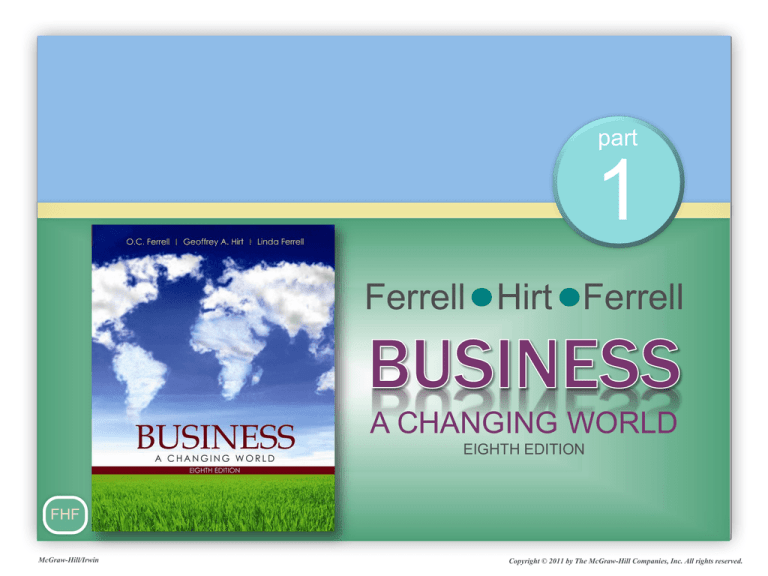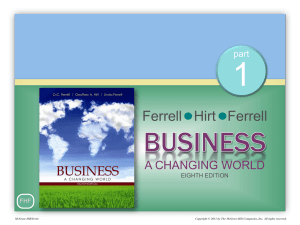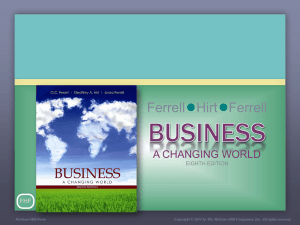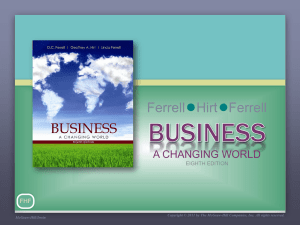
part
1
Ferrell Hirt Ferrell
A CHANGING WORLD
EIGHTH EDITION
FHF
McGraw-Hill/Irwin
Copyright © 2011 by The McGraw-Hill Companies, Inc. All rights reserved.
part
Business in a
Changing World
1
CHAPTER 1 The Dynamics of Business and Economics
CHAPTER 2 Business Ethics and Social Responsibility
CHAPTER 3 Business in a Borderless World
FHF
International Business
The buying, selling and trading of
goods and services across national
boundaries
Global marketing requires balancing
global brands with the needs of local
consumers
FHF
3-3
Why Nations Trade
[
International trade allows for the
acquisition of raw materials and
goods at favorable prices
]
FHF
3-4
Absolute vs.
Comparative Advantages
Absolute Advantage
A monopoly that exists when a country is the
only source of an item, the only producer of an item, or
the most efficient producer of an item.
Comparative Advantage
The basis of the most international trade, when a country
specializes in products that it can supply more efficiently
or at a lower cost than it can produce other items
FHF
3-5
Outsourcing
The transferring of
manufacturing or other tasks,
such as data processing, to
countries where labor and
supplies are less expensive
FHF
3-6
Exporting & Importing
Exporting
The sale of goods and services to foreign markets
The US exports over $1.5 trillion in goods and services annually
Importing
The purchase of goods and services from foreign sources
The U.S. imports around $2 trillion in goods and services annually
FHF
3-7
Balance of Trade
The difference in the value between what a
nation exports and imports
U.S.Trade Deficit
1980
1990
2000
2006
2008
2009
Exports
333
578
1,133
1,437.8
1,843
1,553.1
Imports
326
632
1,532
2.201.4
2,520.1
1,933.7
Surplus
/ Deficit
7
-57
-399
-763.3
-677.1
-380.7
A Trade Deficit
The U.S. imports
more than it exports.
Therefore, the U.S.
has a trade deficit.
(in billions of dollars)
Source: “Foreign Trade Statistics, U.S. Census Bureau
The trade deficit is also called a nation’s negative balance of trade
FHF
3-8
U.S. Exports to China
Have Increased
U.S. Exports to China (in millions of U.S. dollars)*
Source: “Trade in Goods (Imports, Exports and Trade Balance) with China,” U.S. Census Bureau: Foreign Trade
Statistics, http://www.census.gov/foreign-trade/balance/c5700.html..
FHF
3-9
Top 10 Countries Maintaining Trade
Deficits/Surpluses with the US
FHF
3-10
Balance of Payments
The difference between the flow of money
in and out of a country
A nation’s balance of trade, foreign investments,
foreign aid, loans, tourists dollars and military
expenditures comprise its balance of payments
FHF
3-11
Barriers to International Trade
Completely free trade seldom exists.
Barriers to international trade:
• Economic
• Social
• Legal
• Cultural
• Political
• Technological
FHF
3-12
Economic Barriers to Trade
Economic development
Infrastructure
Exchange rates
Less-Developed Countries (LCDs)
•
•
Low per-capita income
•
Potentially huge & profitable markets
•
Largely located in Africa, Asia and Latin America
Less economically advantaged
FHF
3-13
Infrastructure
[
The physical facilities that support economic
activities, including railroads, highways, ports,
airfields, utilities, power plants, schools, hospitals
and commercial distribution systems
]
FHF
3-14
Exchange Rates
[
The ratio at which one nation’s currency can be
exchanged for another nation’s currency
]
FHF
3-15
Ethical, Legal & Political Barriers in
International Trade
Complex relationships between nations
Different laws
Differing intellectual property protections
Trade restrictions
Political barriers and volatility
Cultural differences
Different ethical values
FHF
3-16
Legal Barriers to Trade
Tariff and Trade Restrictions
•
•
Part of a nation’s legal structure
May be established or removed for political reasons
Import Tariff
•
A tax levied by a nation on goods imported into the country
Exchange Controls
•
Regulations that restrict the amount of currency that can be
bought or sold
…continued on the next page
FHF
3-17
Legal Barriers to Trade
Quota
•
A restriction on the number of units of a particular
product that can be imported into a country
Embargo
•
A prohibition on trade for a particular product
Dumping
•
The act of a country or business selling products at less than
what it costs to produce them
FHF
3-18
Political Barriers to Trade
Seldom in writing & change rapidly
Relative stability of countries is a factor
Cartel
A group of firms or nations that agrees to act as a monopoly and
not compete with each other, in order to generate a competitive
advantage in world markets
FHF
3-19
Cultural Barriers
FHF
3-20
Technological Barriers
Technological advances are
creating global
marketing opportunities
At least 10 nations outrank the U.S.
in terms of subscribers to
broadband Internet access
China and India are rapidly
advancing and represent huge
markets
FHF
3-21
Trade Agreements, Alliances
& Organizations
General Agreement on Tariffs and Trade (GATT)
Signed by 23 nations in 1947
Forum for tariff negotiations
Place for international trade issue discussion and resolution
Replaced by the World Trade Organization (WTO) in 1995
…continued on the next page
FHF
3-22
Trade Agreements, Alliances
& Organizations
World Trade Organization (WTO)
International organization dealing with the rules of trade between
nations
Officially founded in 1995
Successor to GATT
153 members representing 95% of global trade
…continued on the next page
FHF
3-23
Trade Agreements, Alliances &
Organizations
North American Free Trade Agreement (NAFTA)
Agreement that eliminates most tariffs and trade restrictions
on agricultural and manufactured products to encourage trade
among Canada, the U.S. and Mexico
Has been controversial, but has created new business opportunities
with fewer barriers than before
…continued on the next page
FHF
3-24
Trade Agreements, Alliances &
Organizations
European Union (EU)
A union of European nations established in
1958 to promote trade among its members
One of the largest single markets today
Asia-Pacific Economic Cooperation (APEC)
An international trade alliance that promotes
open trade and economic and technical
cooperation among member nations
…continued on the next page
FHF
3-25
Trade Agreements, Alliances &
Organizations
World Bank (International Bank for
Reconstruction and Development)
Organization established in 1946 by industrialized nations
to loan money to underdeveloped and developing
countries
International Monetary Fund (IMF)
Organization established in 1947 to promote
trade among member nations by eliminating
trade barriers and fostering financial cooperation
FHF
3-26
Getting Involved in
International Business
Exporting & importing
Trading companies
Licensing and franchising
Contract manufacturing
Joint ventures
Direct investment
Multinational corporations
Many companies’ involvement in international trade begins with
importing goods for resale
FHF
3-27
Getting Involved in
International Trade
Countertrade Agreements
Bartering products for other products instead of
for currency
Export agents are middlemen that help companies by
handling their international transactions
Trading Company
Buys goods in one country and sells them to buyers of
another country
Handles all activities required to move products from one
country to another
FHF
3-28
Licensing
A trade arrangement where one company allows
another company to use its company name, products,
patents, brands, trademarks, raw materials, and production
processes in exchange for a fee or royalty
Many products are licensed and produced by local companies
internationally
Amstel Lager beer produced by Namibian
company Namibia Breweries under a license
from Heineken
FHF
3-29
Franchising
A form of licensing where a company (franchiser) agrees
to provide a franchisee a name, logo, operational guidelines,
products, etc., in return for a financial commitment and the
agreement to conduct business in accord with the franchiser’s
standard of operation
McDonald’s is the world’s largest franchise in terms of
revenues
Includes restaurants in 118 countries
FHF
3-30
Contract Manufacturing
The hiring of a foreign company to produce a
specified volume of the initiating company’s
product to specification
The final product carries the domestic firm’s name
Many clothing manufacturers use contract manufacturing
Common in high-tech industries, automotive industry and food
manufacturing
FHF
3-31
Offshoring
The relocation of a business process by a
company or subsidiary to another country
Different from outsourcing
The company retains control of the process
Not subcontracting to a different company
Appealing because of lower wages, high skills, time zone differences
FHF
3-32
Other Forms of Engaging in
International Trade
Joint Venture
The sharing of the costs of operation of a business
between a foreign company and a local partner
Strategic Alliance
A partnership formed to create competitive advantage on a
worldwide basis
Direct Investment
The ownership of overseas facilities
FHF
3-33
Joint Ventures
Wal-Mart engaged in a 50/50 joint venture with
India business group Bharti Enterprises Ltd.
•
Indian laws prohibit foreign direct investment in
the retail sector
The stores are called Best Price Modern Wholesale
•
Are members-only wholesale stores for other
Indian retailers
•
Different model than Walmarts elsewhere
FHF
3-34
Ten Largest Global Corporations
1.
2.
3.
4.
5.
Royal Dutch Shell
ExxonMobil
Wal-Mart Stores, Inc.
BP
Chevron
6. Total
7. ConocoPhillips
8. ING Group
9. Sinopec
10. Toyota Motors
(Source: “The Global 500,” Fortune 2009)
FHF
3-35
Multinational Corporations
The highest level of international business involvement
Largest MNCs are wealthier than most countries
Operates on a worldwide scale without significant ties to a
single nation or region
Antiglobalization activists contend that MNCs are
responsible for growing wealth disparity and misusing
scarce resources
FHF
3-36
International Business Strategies
Multinational Strategy
A plan used by international companies that involves
customizing products, promotion and distribution according to
cultural technological, regional and national differences
Global Strategy (Globalization)
A strategy that involves standardizing products (promotion and
distribution) for the whole world as if it were a single entity.
FHF
3-37
Managing the Challenges of
Global Business
Many political barriers to trade have fallen in
recent decades
Navigating international business remains complicated
Governments and business organizations exist to help businesses
looking to go international
Technology and improved standards of living globally are creating
tremendous new marketing opportunities
FHF
3-38










